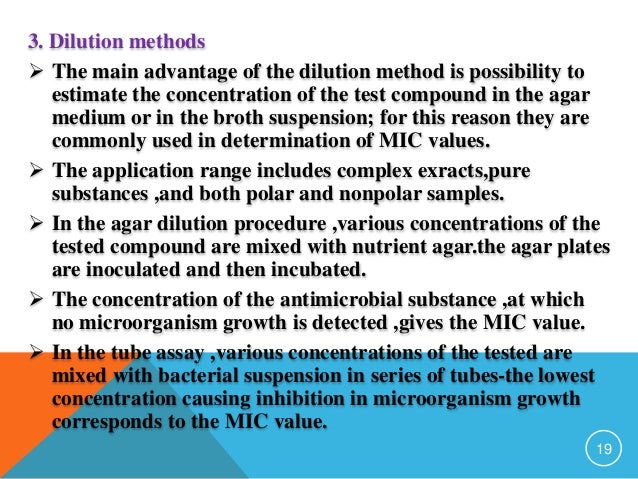Mar 1, 2018 - Best Answer: Serial dilution direct count: Advantages: Count all the cells living or dead Results would be quickly obtained Disadvantage: Can't. The serial dilution technique1 using pipets is a well-established way to. Direct dilution provides a number of advantages over serial dilution. • This technique is based upon the ability of a single organism to multiply in the. What is the advantages and disadvantages to the serial dilution agar plate.
Each calibration standard solution is prepared based on the previous calibration standard. The process involves taking a portion of the previous standard and diluting it with the solvent to obtain the next calibration standard. The errors introduced with each successive dilution drops proportionately with the solution concentration. Preparing a series of calibration standards by this method reduces the amount of required time.
Most calibration standards span a large range of concentrations, so the accuracy of the calibration standard prepared increases. Calibrations Solutions More Evenly Spaced. The dilution factor chosen for the series of calibration standards is achievable by using serial dilution.
One of the largest-volume post-WWII applications was in the basic design of television sweep power tubes, starting with the 6BG6G (1946), a modified. Peredatchik na lampe 6p3s s p konturom. TV designs rarely used in place of sweep tubes—a challenging high-power and high-speed application—until the 1970s.
Windows 7 lite dlya netbukov torrent. Windows 7 Super Lite Edition Windows 7 Super Lite Edition x86 2017 is the best Version based on the full version of Ultimate SP1 and the original Microsoft And files were deleted unimportant and unnecessary language packs them Version ships with all features in addition towards the well-known figure pictures que and fascinating themes.
The progression of calibration standard concentration is always a geometric series. Consider the example of making the first standard at 1/3 the concentration of the known, the next calibrant would be 1/9th the concentration of the known and the following two calibrants formed are 1/27th and 1/81st. This becomes a much greater advantage when the span of the calibration standards must cover several orders of magnitude in concentration.

March 15, 2007 Many laboratory protocols require the serial dilution of reagents or compounds. IC50 assays, commonly used to evaluate drug efficacy, and assay development procedures, as well as standard-curve generation, involve the serial dilution of compounds, proteins, or detection agents. These processes can be streamlined by utilizing automated liquid-handling equipment with serial dilution capabilities. Serial dilution processes face two major challenges.
The first is error propagation across columns or rows. With each sequential serial dilution step, transfer inaccuracies lead to less accurate and less precise dispensing. The result is that the highest dilutions will have the most inaccurate results. To compensate for this error possibility, longer mixing times are required, which then increases the time required to perform the serial dilution. These challenges greatly limit the throughput capacity of an automated serial dilution system. To overcome these challenges, the effects of various mixing parameters of a serial dilution protocol were explored. Velocity11’s (www.velocity11.com) Bravo™ Liquid Handling Platform performed serial dilution with the same pipette head as a full plate dispenser (Figure 1).

With the platform’s VWorks™ software, the application allowed the total control of liquid transfer and mixing heights and speeds, which allowed efficient exploration of mixing parameters. The goals were to determine which parameters had the greatest effect on mixing and to reduce the time required to perform a serial dilution.